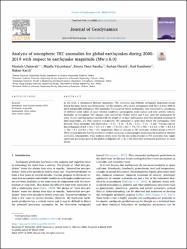Ara
Toplam kayıt 23, listelenen: 1-10
Analysis of ionospheric TEC anomalies for global earthquakes during 2000-2019 with respect to earthquake magnitude (Mw >= 6.0)
(Pergamon-Elsevier Science Ltd, 2020)
In this work, a relationship between ionospheric TEC anomalies and different earthquake magnitude groups before the main shocks was investigated. For this purpose, 2942 global earthquakes with Mw >= 6 from 2000 to 2019 and ...
Late Jurassic Magmatism and Stratigraphy in the Eastern Sakarya Zone, Turkey: Evidence for the Slab Breakoff of Paleotethyan Oceanic Lithosphere
(Univ Chicago Press, 2017)
Middle-Late Jurassic Cimmerian events in Turkey have been actively discussed in the past three decades, but proposed tectonic models associated with magmatism, metamorphism, and stratigraphic features remain controversial. ...
Investigation of the Relationship among Fault Types, Focal Depths, and Ionospheric TEC Anomalies before Large Earthquakes between 2000 and 2020
(ASCE-AMER SOC CIVIL ENGINEERS, 2022)
In this study, the relationships between possible ionospheric total electron content (TEC) anomalies and earthquake focal depths and fault types were investigated using 3,099 global earthquakes with Mw >= 6.0 between 2000 ...
Post-Variscan autochthonous cover in the eastern Sakarya Zone, Turkey: Evolution of the late Carboniferous back-arc ocean to the Triassic Karakaya Ocean
(Elsevier Ltd, 2023)
The processes that caused removal of the upper Carboniferous to Permian sediments in the eastern Sakarya Zone, Turkey, are modeled by using of geochemical data and LA-ICP-MS U–Pb ages from detrital zircons. A felsic ...
Zircon Lu-Hf isotope systematics and U-Pb geochronology, whole-rock Sr-Nd isotopes and geochemistry of the early Jurassic Gokcedere pluton, Sakarya Zone-NE Turkey: a magmatic response to roll-back of the Paleo-Tethyan oceanic lithosphere
(Springer, 2017)
The early Mesozoic was a critical era for the geodynamic evolution of the Sakarya Zone as transition from accretion to collision events in the region. However, its complex evolutionary history is still debated. To address ...
Lithostratigraphy, facies, and deposition environment of the lower Jurassic Ammonitico Rosso type sediments (ARTS) in the Gumushane area, NE Turkey: Implications for the opening of the northern branch of the Neo-Tethys Ocean
(Pergamon-Elsevier Science Ltd, 2009)
Ammonitico Rosso type sediments (ARTS) form the bottom level of the Senkoy Formation in the Gumushane area. The formation accumulated in the rift-related basins triggered by extensional tectonic regimes in the Early Jurassic ...
A new Early Jurassic brachiopod fauna from the Eastern Pontides (Turkey)
(E Schweizerbartsche Verlags, 2011)
A newly collected Early Jurassic brachiopod fauna from the Kocamantasi section (Gumushane region, Eastern Pontides, Turkey) yielded 160 specimens and 13 species (4 rhynchonellids, 3 spiriferinids, 6 terebratulids). Apart ...
The Sumela Monastery slope in Macka, Trabzon, Northeast Turkey: rock mass properties and stability assessment
(Springer Heidelberg, 2011)
In 2001, rock falls occurred on the southern slope of the Sumela Monastery, which was built on a cliff in Trabzon, north east Turkey, and is visited by many tourists. Considering the steepness of the slope and difficulty ...
Subduction-related Late Carboniferous to Early Permian Magmatism in the Eastern Pontides, the Camlik and Casurluk plutons: Insights from geochemistry, whole-rock Sr-Nd and in situ zircon Lu-Hf isotopes, and U-Pb geochronology
(Elsevier, 2016)
Late Carboniferous to early Permian granitoid rocks represent a volumetrically minor component of the Eastern Pontide lithosphere, but they preserve useful information about the region's tectonomagmatic history. The Casurluk ...
A-type granitoids from the Eastern Pontides, NE Turkey: Records for generation of hybrid A-type rocks in a subduction-related environment
(Elsevier, 2012)
The Eastern Pontides is characterized by the many of intrusive bodies formed throughout the late Mesozoic-early Cenozoic. Most of these are I-type granitoids, but here, we present for the first time an A-type pluton from ...
















